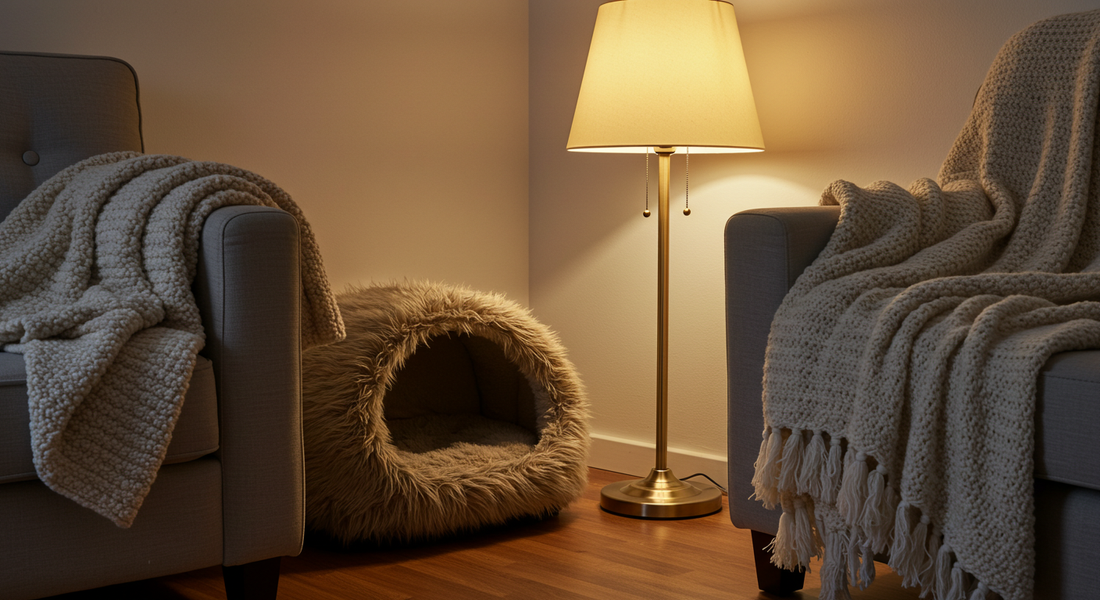
Creating Calming Spaces for Anxious Pets: Beds, Diffusers, and More
Share
1. Introduction: A Safe Haven for Stressed Pets
Just like humans, pets can experience anxiety — from loud noises and unfamiliar environments to changes in routine or separation. Creating a calm, secure space in your home can make a world of difference for their emotional well-being.
At Snuggle & Go, we understand that comfort goes beyond soft fabrics; it’s about fostering a sense of safety. With the right mix of calming beds, soothing scents, and thoughtful design, you can transform any corner of your home into a peaceful retreat for your furry companion.
2. Understanding Pet Anxiety
Before setting up a calming space, it’s important to recognize what triggers your pet’s stress. Common causes include:
-
Loud noises (fireworks, thunderstorms, traffic)
-
Separation from owners
-
New environments or guests
-
Changes in routine or scent
-
Traveling or vet visits
Anxiety can show through restlessness, panting, excessive licking, or hiding. Understanding your pet’s behavior helps you tailor their space to what truly soothes them.
3. The Foundation: Choosing the Right Bed
A cozy, supportive bed is the heart of any calming space. Pets need a soft, enclosed area where they can feel protected yet comfortable.
Calming Bed Features to Look For:
-
Bolstered Sides: Provide a sense of security and a place to rest their head.
-
Orthopedic Memory Foam: Ideal for older pets or those with joint pain.
-
Soft, Plush Fabrics: Faux fur and sherpa mimic the comfort of being close to their owner or littermates.
-
Removable Covers: Easy to wash, maintaining a clean and fresh environment.
Placement Tip: Position the bed in a quiet corner away from heavy foot traffic or direct noise sources. Near a wall or in a cozy alcove works best.
4. The Power of Scent: Diffusers and Aromatherapy
Smell is one of the most influential senses for animals. Certain scents can instantly soothe an anxious pet.
Pet-Safe Diffusers and Sprays:
Look for diffusers that release calming pheromones or natural aromas like chamomile, lavender, or cedarwood. These mimic natural comforting signals and help pets feel relaxed and secure.
Avoid human-grade essential oils — they can be too strong or even toxic to pets. Instead, choose vet-approved, pet-specific diffusers designed to deliver gentle, safe fragrance levels.
Pro Tip: Use diffusers in short intervals and monitor your pet’s response to avoid overstimulation.
5. Textures and Fabrics: Comfort Through Touch
The right textures can drastically reduce anxiety. Soft, weighted, and warm materials help create an atmosphere of reassurance.
Recommended Fabrics:
-
Velvet or Faux Fur: Offers warmth and softness that encourages snuggling.
-
Cotton or Linen: Breathable and natural for warmer climates.
-
Weighted Blankets: Gentle pressure can calm anxious pets, mimicking the feeling of being held.
Layering these materials adds a sense of luxury and comfort while helping your pet self-soothe naturally.
6. Lighting and Sound: Setting the Mood
Creating a serene environment goes beyond physical comfort — it’s about atmosphere.
-
Soft Lighting: Avoid bright overhead lights. Instead, use warm-toned lamps or nightlights to create a cozy glow.
-
Soundscapes: Gentle background noise such as calming music, nature sounds, or white noise can mask external disruptions.
-
Routine Quiet Time: Schedule daily “calm sessions” where distractions are minimized, and your pet can rest peacefully.
A consistent routine paired with a soothing sensory environment can significantly ease daily anxiety.
7. Creating Multi-Purpose Calming Corners
In smaller homes or apartments, space may be limited — but even a small corner can be transformed into a peaceful sanctuary.
Ideas for Small-Space Calm Zones:
-
Under Tables or Desks: Add a plush bed and blanket to create a semi-enclosed retreat.
-
Beside Furniture: Use soft rugs and low lighting to designate a cozy nook.
-
Window Views: For cats or curious pets, a perch near a window provides visual comfort and distraction.
Choose a spot your pet naturally gravitates toward — familiarity is key to helping them relax.
8. Toys, Chews, and Distraction Tools
Calmness doesn’t always mean complete stillness. Many pets soothe themselves through gentle play or chewing.
-
Chew Toys: Help release tension and prevent destructive behavior.
-
Snuffle Mats: Engage the sense of smell and encourage slow, mindful activity.
-
Plush Toys: Provide comfort through familiarity and scent retention.
Keeping a small selection of comforting toys within their calming space reinforces a sense of safety.
9. Additional Stress-Relief Aids
Sometimes, extra tools can help promote calm in anxious pets — especially during high-stress situations like storms or travel.
Consider Adding:
-
Weighted Pet Vests or Anxiety Wraps: Provide gentle, constant pressure for comfort.
-
Cooling or Heating Pads: Regulate temperature and promote relaxation.
-
Calming Treats or Supplements: Natural options like L-theanine or chamomile can help — consult your vet before use.
Together, these aids can turn moments of tension into opportunities for soothing and connection.
10. Sustainability Meets Serenity
Calming spaces can also be eco-conscious. Choose products made from organic cotton, recycled fibers, or biodegradable fillers.
Sustainable fabrics are breathable and non-toxic — ensuring both comfort and peace of mind.
At Snuggle & Go, we value mindful living — designing spaces that care for your pets and the planet they play on.
11. Conclusion: Comfort, Calm, and Connection
Creating a calming space for your pet is one of the most loving gestures you can make. From plush beds to pet-safe diffusers and sensory-friendly designs, each detail works together to ease anxiety and promote well-being.
When pets feel secure, they thrive — emotionally, physically, and behaviorally.
At Snuggle & Go, we believe a peaceful home starts with your pets. Thoughtful design and mindful choices help you nurture calm, happy companions who feel truly at home.
